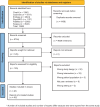Educational programmes for paediatric healthcare professionals in patient- and family-centred care. A scoping review
- PMID: 38430279
- PMCID: PMC11035470
- DOI: 10.1007/s00431-024-05455-0
Educational programmes for paediatric healthcare professionals in patient- and family-centred care. A scoping review
Abstract
To identify and describe educational programmes in patient- and family-centred care for paediatric healthcare professionals. This scoping review was conducted and reported according to the JBI Manual for Evidence Synthesis and the PRISMA guideline. The databases searched included MEDLINE (PubMed), PsycINFO, CINAHL, Scopus, Cochrane, and Embase. Inclusion criteria were experimental, observational and qualitative studies about educational programmes on patient- and family-centred care for paediatric healthcare professionals. Exclusion criteria were reviews and non-peer-reviewed literature. Two reviewers independently screened and extracted the data using Covidence. Of the 13922 records identified, 49 articles met the inclusion criteria. There was a large variety of educational programmes, half of which were interdisciplinary, that mainly targeted nurses and doctors. The median number of participants was 51 (range 7 to 1411). The predominant target population was children with chronic disabilities and neonatal intensive care units, and only one programme specifically targeted adolescents. The median duration was one day (range 5 min to 3.5 years). Development of competencies was the most common objective. We identified 12 different educational content areas. Content mainly focused on communication and relational competencies, including partnership, which involved shared decision-making, mutual agenda setting, and negotiation of a plan. Many kinds of educational strategies were found but experiential learning through simulation and roleplay was used most. Conclusion: A large variety of educational programmes in paediatric patient- and family-centred care exist. Educational content mainly focused on communication and relational competencies. Experiential learning including roleplay and simulation was the most used educational strategy. What is Known: • Delivery of patient- and family-centred care improves parental satisfaction of care but requires clinicians have a certain attitude towards involving the child and parents in a healthcare partnership as well as advanced triadic communication skills. Little is known about how this attitude, and more broadly, patient- and family-centred care, can be facilitated through education and training. What is New: • This scoping review found a wide array of programmes.. Workshops with simulation or roleplay was the most frequent educational strategy. The programmes, which typically targeted nurses and doctors, chiefly focused on basic and advanced communication and relational competencies, including partnership, which involved shared decision-making and negotiation of plans.
Keywords: Education; Healthcare professionals; Paediatric; Patient- and family-centred care.
© 2024. The Author(s).
Conflict of interest statement
The authors declare no competing interests.
Figures



References
Publication types
MeSH terms
LinkOut - more resources
Full Text Sources
Medical
Miscellaneous

